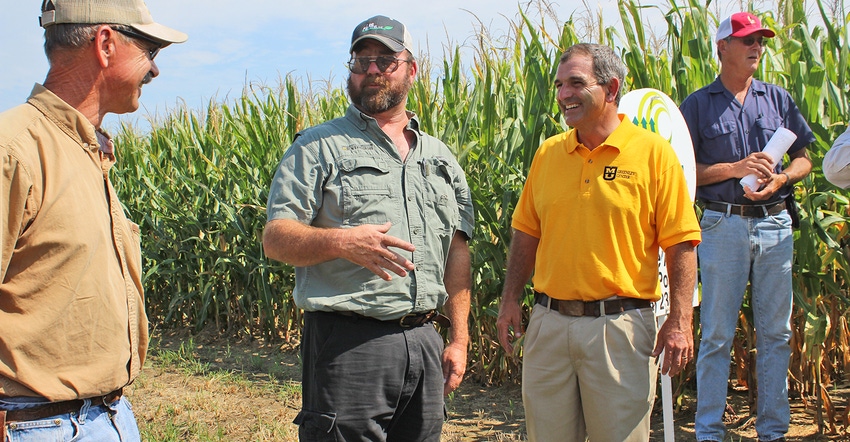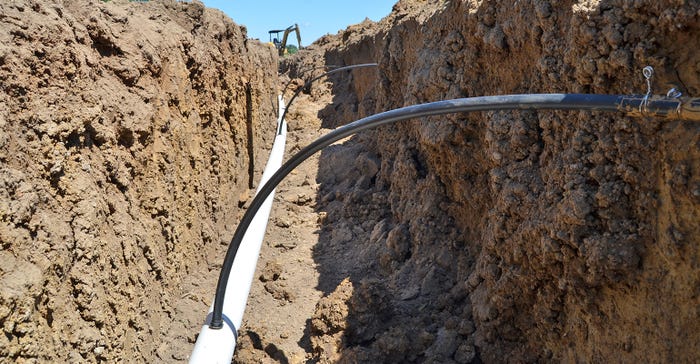
University of Missouri agronomists Kelly Nelson and Rusty Lee field a number of phone calls regarding subsurface drip irrigation. While the system that provides water to crops through buried drip irrigation tape has been around for close to 60 years, farmers in the Midwest have recently seen its benefits and want to know more.
Here are a few questions the two have received over the years.
1. What type of farming operation works best for SDI? Drip irrigation works differently for corn and soybeans, Lee says. Soybeans need less water early in the season, but more later. He says the biggest benefit will be on corn acres. “The single largest limiting factor to corn yield in our state is water,” Lee says. SDI can provide water when the plant needs it most. “It will work well in those drought years.” Nelson agrees. “With the new hybrids we’ve got, it doesn’t take much, it just takes one timely irrigation event to get the most out of them," he says.
2. While SDI works on many different land topographies? According to Nelson, there are two types of farms he focuses on — those with oddly shaped fields and those with hill ground. “On those irregularly shaped fields you can put drip tape into those nooks and crannies, along the fence line or tree line, and really see great results in plant growth and yields,” he says. For hill ground, it is a matter of keeping the moisture in place. “These are acres where water typically runs off,” he says. “With a slow release the water can be taken up by the plant.”
Nelson adds that SDI works for areas that might not be suitable for overhead or pivot irrigation.
3. How deep should drip tape be placed? The answer depends on soil type and field location. MU is currently conducting research on drip tape depth at Lee’s farm. There, they are looking at 12-inch and 16-inch depths. So far, he is having good results with placing the black drip tape at 16 inches. Nelson has some tape as shallow as 14 inches.
4. What is the optimum distance between each drip tape? Lee uses 5 feet of distance between each drip tape in east central Missouri. In the rolling hills of northwest Missouri, Nelson is experimenting with wider spacings. “We are looking at spreading out the spacing to see, if on those slopes, we can get lateral flow of water,” he says. He has SDI plots with spacings of 5 feet, 7.5 feet and 10 feet. Nelson adds that realizing lateral flow could make the system more cost effective for producers.
 WHAT LIES BENEATH: Black plastic drip tape runs across a soybean field in Montgomery County. The lines hook into the PVC piping connected to a water pump at a nearby pond which will provide water to 14 acres.
WHAT LIES BENEATH: Black plastic drip tape runs across a soybean field in Montgomery County. The lines hook into the PVC piping connected to a water pump at a nearby pond which will provide water to 14 acres.

5. How much water supply is needed? Farmers can either use a well or a pond as a water source. Both need to be in close proximity of the field. How much water depends on the amount of drip tape in the field. Lee uses SDI zones allowing him to maximize the use of water. He found that by running the water pump 8 hours to mimic .2 inches of rainfall, he could irrigate 26 acres on a 100 gallon per minute well.
6. Does water quality matter? The system should have a water filtration component. And while it can remove or treat for certain water concerns like calcium, SDI does not handle iron well. Craig Pisarkiewicz, certified drip irrigation designer at MPR Supply Co., says that if the iron content is higher than 5 parts per million, the system does not work well. He tried SDI in the Missouri Bootheel and along the Missouri River in Labadie, Mo., where there was high iron concentration. “It did not work there at all,” he says. Pisarkiewicz recommends getting the water source tested before getting too far along in the process.
7. Can I run fertilizer or nutrients through the system? For Lee, adding fertilizer is a bonus to SDI. “The fact that you can use it for fertigation and address plant nutrition through the line is huge,” he says. “You can almost spoon feed that plant.” Rather than two or three nitrogen applications per season, farmers can have 10 to 12, putting smaller amounts on at a time that fits the need requirements of the plants. “And on those low humidity, high wind days, you have a lack of application evaporative losses in drip versus overhead irrigation,” he adds.
8. Does the system improve yields? Nelson has studied SDI and yields for 10 years. He found that systems increased soybean yields 9 to 14 bushels per acre, and corn yields increased from 25 to 55 bushels.
9. What does an SDI system cost? Landowners estimate $700 per acre to install an SDI system and roughly $31 per acre in energy cost if a farmer is using a well pump as the water source.
10. What is the biggest drawback to SDI? “Varmints,” Lee says. Mice like chewing on the black plastic tape. Nelson finds the first year is typically the worst. “The goal is to lay the tape as deep as possible so the rodents have to work harder to get to it,” he says. Nelson plowed the tape in a mild fall with lots of cover on the ground — he uses no-till practices. The open spot in the ground was warm, and the mice found their way to the tape. “It was not a happy spring,” he says. He had corn shin high and wet spots across the field. However, fixing the leaks was simple. Nelson shut off the water, used a small shovel, pulled back the wet slurry and secured a compression coupler.
Both Nelson and Lee assist farmers in designing SDI systems. Farmers can also reach out to professional irrigation design companies or irrigation companies for advice.
About the Author(s)
You May Also Like






